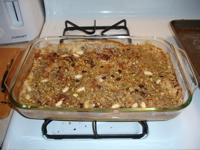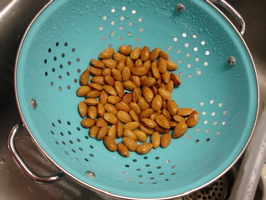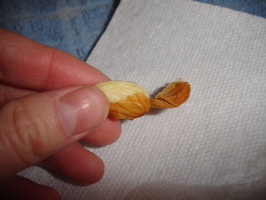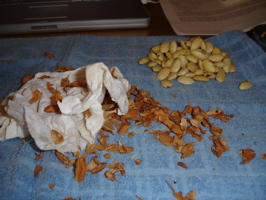Laser head patterns
I was back in Austin for Thanksgiving last week. While hanging out in the room where my dad tutors his students, undoubtedly chatting with him about what on earth I’ll do next year, I started playing with his laser pointers. He has two, one of which has multiple heads that you can screw on to get different pointer shapes (like this one). There are heads for an arrow, a circle, a line, and a cross, in addition to the normal pointer. The heads look like basically like a piece of glass in a metal frame, and I wondered: What are the patterns on the glass that produce these different pointer shapes?
Miraculously, I also happened to notice that my dad now has a little microscope! So I plunked the laser pointer heads underneath it, to try to see what they look like.
And I can’t say that I understood what I saw. For the line-shaped pointer, I saw lots of lines etched in the glass, seemingly in parallel:
But with the arrow-shaped pointer head, I saw something very weird:
…No little arrows all over, but rather, a pixelated etching of wavy lines! All I can imagine is that this is something like one of those Magic Eye pictures where an image appears when everything lines up just right.
Does anyone know how this works?
Martin Wattenberg’s advice to me
Tonight I went to see Martin Wattenberg (from IBM’s Visual Communication Lab) talk about visualizing the patterns in Wikipedia edit histories (see history flow and chromogram). It was very fun, very interesting, and makes me think it’s possible to have a job that feels like play.
Afterwards I asked Martin if he had any advice for me, as I’m about to embark on my Masters thesis work, which is really just a big visualization project devoted to looking at people’s music collections. I was wondering what kinds of coding tools he’d recommend. (All of his Wikipedia visualizations were built in Java.) He said, “You’ve got one big question to answer first… Do you want to put this on the web, or not?” If I want it on the web, he says, go Flash; if not, try Processing. And he strongly suggested making it for the web, because that creates the possibility for an instant community and lets the project take on a life of its own.
Thursday, November 15, 7-9 pm
Visualizing Wikipedia: A tale of life, love, and bureaucracy
Martin Wattenberg and Fernanda Viegas (in spirit) , IBM Visual Communication Lab
Abstract: We report on Wikipedia’s evolution from a curiosity to a point of first
reference for millions. Applying data visualization techniques to
Wikipedia’s historical archives uncovers a story in three acts: life, love,
and bureaucracy. “Life” refers to the impressive ability of Wikipedia to
heal itself after vandalism and errors. “Love” is reflected in the
overwhelming scale of individual production and the passion shown by devoted
editors. And bureaucracy–an unexpected aspect of a free-spirited
community–is becoming prevalent as the site scales, with emerging
formalized processes and roles that help ensure quality.
Dry skin on airplanes
Ian and I have been on planes a lot recently. The last time we were about to board flights going in opposite directions, we were complaining about how dry the air is on those planes… making you thirsty, and worse, drying up your skin.
And why does your skin get so dry? All of these reasons are caused by the high altitudes (>25,000 ft) at which many planes fly:
- Low humidity: Relative humidity is less than 25% on airplanes, and can go as low as 1%. This is way worse than the Sahara, apparently. Here are some things you can do to fight that dry air, although I don’t intend to apply an edible vegetable oil inside my nostrils.
- Low oxygen content: Healthy skin needs oxygen ((“Special Focus Topic: Skin Care.” DOI: 10.1177/014572170403000616; 2004; 30; 952 The Diabetes Educator.)) ((The Look You Like: Medical Answers to 400 Questions on Skin and Hair Care (p. 116) [This article states the importance of oxygen for skin, but also suggests you can’t just apply oxygen to skin to make up for it (which is what a LOT of skin care products would have you think).])), and it doesn’t get it at those high altitudes.
- High ozone levels: “the combination of ozone and the oils in skin, hair and clothing is producing toxic chemicals known to cause headaches, nasal irritation, and a number of other symptoms associated with ‘sick building syndrome’, including dry, itchy skin.” ((http://www.theopenpress.com/index.php?a=press&id=23934)) Installing ozone-destroying catalysts in all planes could help.
I can’t even imagine what it’s like for flight attendants’ skin. :(
Blanching almonds
 I made this delicious creamy phyllo, raisin and nut pudding (“om Ali” ((This name always makes me end up singing… “Come on Eileen”!)) ) for a friend’s birthday dinner on Saturday. This dish is awesome because:
I made this delicious creamy phyllo, raisin and nut pudding (“om Ali” ((This name always makes me end up singing… “Come on Eileen”!)) ) for a friend’s birthday dinner on Saturday. This dish is awesome because:
- It is a pudding.
- It uses orange blossom water ((If you live in the Boston area, you can buy this at Christina’s Spice & Specialty Foods in Inman Square.)), which smells beautiful. Your house will smell like orange blossom water as the pudding bakes, and, really, this is worth it even if you don’t get to eat (all) the pudding.
Beforehand, I was standing in Trader Joe’s, looking for blanched almonds for the pudding, but they didn’t sell any. After a quick poke, the helpful TJ’s employee told me I could blanch my own. So I left the store with a bag of whole, unsalted, raw almonds.
Blanching them was very simple, but a little tedious. One minute under boiling water, and the skins come off with some tugging. (I followed these instructions.) It was slow-going; I think it took me almost 15 minutes to do 1/4 cup of almonds.
Martian colors
 I went to see Oliver Sacks talk about his new book Musicophilia at the Cambridge Forum on Monday night, in Harvard Square. He described one very interesting phenomenon that I’ve never heard of before… that colorblind people with synesthesia can sometimes have associations that result in the perception of colors they have never seen in the real world. These colors are called “martian colors”.
I went to see Oliver Sacks talk about his new book Musicophilia at the Cambridge Forum on Monday night, in Harvard Square. He described one very interesting phenomenon that I’ve never heard of before… that colorblind people with synesthesia can sometimes have associations that result in the perception of colors they have never seen in the real world. These colors are called “martian colors”.
(Much more info in this great blog post.)
Canary Islands named after dogs
I just reviewed a couple of papers for the 2008 International Conference on Intelligent User Interfaces, which will be in the Canary Islands. Reminding myself where the Canary Islands are (west of Morocco! …even though they are Spanish islands) led me to the wikipedia page, which tells me that the Canary Islands are likely named from the Latin term Insula Canaria, meaning “Island of the Dogs”, and the canary birds are probably named after the islands.
(Much more info here.)









